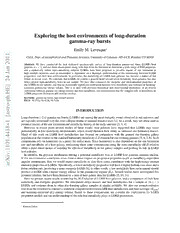
Exploring the host environments of long-duration gamma-ray bursts PDF
Preview Exploring the host environments of long-duration gamma-ray bursts
Exploring the host environments of long-duration gamma-ray bursts Emily M. Levesque1 1 1 CASA,Dept.ofAstrophysicalandPlanetarySciences,UniversityofColorado389-UCB,Boulder,CO80309 0 2 Abstract. We have conducted the first dedicated spectroscopic survey of long-duration gamma-ray burst (LGRB) host n galaxiesatz<1,andusetheseobservationsalongwithdatafromtheliteraturetodetermineawiderangeofISMproperties a and a statistically robust mass-metallicity relation. LGRBs have been proposed as possible tracers of star formation at J high redshift; however, such an association is dependent on a thorough understanding of the relationship between LGRB 4 progenitors and their host environments. In particular, the metallicity of LGRB host galaxies has become a matter of hot 2 debateinrecentyears.WeconcludethatLGRBsdoexhibitageneraltrendtowardlower-metallicityhostgalaxies,butalso detect several high-metallicity hosts in our sample. We have also compared the energetic and environmental properties of ] theLGRBsinoursample,andfindnostatisticallysignificantcorrelationbetweenhostmetallicityandisotropicorbeaming- E corrected gamma-ray energy release. This is at odds with previous theoretical and observational predictions of an inverse H correlationbetweengamma-rayenergyreleaseandhostmetallicity,anddemonstratesthatthecomplexroleofmetallicityin LGRBprogenitorformationstillremainsunclear. . h Keywords: gamma-raybursts;highredshiftgalaxies p PACS: 95.75.Fg,98.62.Bj,98.70.Rz - o r t INTRODUCTION s a [ Long-duration(>2s)gamma-raybursts(LGRBs)areamongthemostenergeticeventsobservedinouruniverse,and 1 aretypicallyassociatedwiththecore-collapsedeathsofunusualmassivestars[1].Asaresult,theyareoftencitedas v potentialtracersofthestarformationandmetallicityhistoryoftheearlyuniverse[2,3,4]. 8 However, in recent years several studies of these events’ host galaxies have suggested that LGRBs may occur 1 preferentiallyin low-metallicityenvironments,whichwouldthreatentheir utility as unbiasedstar formationtracers. 4 Much of this work on LGRB host metallicities has focused on comparison with the general star-forming galaxy 4 . populationinthecontextofthestandardluminosity-metallicityL-Zrelationforstar-forminggalaxies[5,6,7,8].Such 1 comparisonsrelyonluminosityasaproxyforstellarmass.Sinceluminosityisalsodependentonthestarformation 0 rate and metallicity of a host galaxy,performingthese same comparisonsusing the mass-metallicity (M-Z) relation 1 offersamoredirectmeansofisolatingtheeffectsofmetallicityinthegalaxysamplesandprobingitsroleinLGRB 1 : hostgalaxies. v In addition, the physical mechanism driving a potential metallicity bias in LGRB host galaxies remains unclear. i X Ifthis environmentalcorrelationarisesfroma directimpactonprogenitorproperties(suchasmetallicity-dependent r angular momentum), then we would expectmetallicity to also show some correlation with the high-energyprompt a emissionpropertiesofLGRBs.Specifically,alower-metallicityprogenitorwillhaveahigherheliumcoremassanda fasterrotationrate,producingamoreenergeticLGRB[9];inotherwords,alow-metallicityhostenvironmentshould producea LGRB with a higherenergyrelease in the gamma-rayregime(Eg). Severalstudies have investigatedthis potentialrelation,buthavebeenlimitedbyalackofhostgalaxydataforLGRBs[5,10,11]. HerewepresentrecentresultsexaminingtheM-ZrelationofLGRBhostgalaxies,andacomparisonoftheirhost metallicity and energetic properties. We determined stellar masses and host metallicities for a sample of 16 z<1 LGRBs and compare them to other star-forming galaxy samples at similar redshifts. We also use prompt emission datafromtheliteraturetoconductastatisticalcomparisonbetweenLGRBhostmetallicitiesandtheirisotropic(Eg,iso) and beaming-corrected (Eg) energy release. Based on these comparisons, we consider the implications for LGRB progenitormodelsandourunderstandingoftherolethatmetallicityplaysinLGRBproduction. 1 EinsteinFellow THEMASS-METALLICITY RELATION FOR LGRBS We are conductingan ongoinguniformrest-frameopticalspectroscopicsurveyof z<1 LGRB hostgalaxies,using theKecktelescopesatMaunaKeaObservatoryandtheMagellantelescopesatLasCampanasObservatory[8,12].We haverestrictedoursampletoconfirmedlong-durationbursts,selectedfromtheGHostSarchive[13]andtheGamma- Ray Burst Coordinates Network. To date, this survey has acquired spectroscopic data for 12 z <1 LGRB hosts. Combined with four host galaxies that have high-quality spectroscopic data in the literature, we present a current sampleof16LGRBhostgalaxies. Ourspectrawerefirstcorrectedforthetotalline-of-sightE(B−V),determinedbasedonthefluxesoftheBalmer lines and the standard reddening law [14]. We then determined metallicities based on a calibration of the ([OIII] l 5007+[OIII]l 4959+[OII]l 3727]/Hb (R )diagnostic[15,16].Intwocases(thehostgalaxiesofGRB020405 23 andGRB980703),wecouldnotdistinguishwhetherthehostmetallicitylayonthe“lower"or“upper"branchofthe double-valuedR diagnosticcalibration;wethereforeperformedallsubsequentanalyseswithbothmetallicitiesfor 23 completeness. Finally, several host galaxies (the hosts of GRBs 980425, 990712, 030528, and 050824) fell on the “turn-over"ofthediagnostic,correspondingtothemetallicityoflog(O/H)+12∼8.4.Forourfullsamplewefound anaverageR metallicityoflog(O/H)+12=8.4±0.3. 23 WealsoestimatedstellarmassesforourLGRBhostgalaxies.UsingtheLePhare2code,wefitmultibandphotom- etryforthehostgalaxies[4]tostellar populationsynthesismodelsadoptingaChabrierIMF, theBruzual&Charlot syntheticstellartemplates,andthe Calzettiextinctionlaw [17, 18,19].Thefittingyieldedastellar massprobability distributionforeachgalaxy,withthemedianofthedistributionservingasourestimateofthefinalstellarmass;fora moredetaileddiscussionofthemassdeterminationsee Ilbertetal.(2009)andLevesqueetal.(2010b).Forthreeof the hostsin oursample (thehostsof GRBs 050824,070612A,and 020405)we hadinsufficientphotometricdatato determineastellarmassestimate.Forourremainingsampleof13LGRBhostgalaxies,wefindameanstellarmass oflog(M⋆/M⊙)=9.25+−00..1293. ThemetallicitiesandstellarmassesthatwederivedwereusedtoconstructaM-ZrelationforLGRBhostgalaxies, whichweplotinFigure1.Wefindastrongandstatisticallysignificantcorrelationbetweenstellarmassandmetallicity for LGRB hosts out to z<1 (Pearson’s r=0.80, p=0.001).We also compare our results to two samples of star- forming galaxies in Figure 1. The nearby (z<0.3) LGRB hosts are compared to data from ∼53,000 star-forming SDSS galaxies, while the intermediate-redshift (0.3<z<1) LGRB hosts are plotted with data from a sample of 1,330emissionlinegalaxiesfromtheDeepExtragalacticEvolutionaryProbe2(DEEP2)survey[21,22].Fromthese comparisons,wefindthatmostoftheLGRBhostsinoursamplefallbelowthestandardM-Zrelationforstar-forming galaxiesatsimilarredshifts;thedifferencesrangefrom−0.10to−0.75dexacrossafixedstellarmass,withanaverage offsetfromthegeneralstar-forminggalaxypopulationof−0.42±0.18dexinmetallicity. Interestingly,whileweseeclearevidenceofalow-metallicitytrendinLGRBhostgalaxies,weseenoevidencethat thereisaclearmetallicitycut-offabovewhichLGRBscannotbeformed,aconclusionatoddswithpreviousstudiesof LGRBhostgalaxiesandourcurrentunderstandingoftheirprogenitorevolution[7,8,12,23].Thisismadeparticularly clear in the unusualcases of the high-metallicityGRB 020819Band GRB 050826hosts, both of which agree with the generalstar-forming galaxy samples to within the systematic errors. We determine a globalhost metallicity for GRB 050826,butin the case ofGRB 020819Bwe are able todeterminea metallicityfor theprecise explosionsite oftheGRBandfindanR metallicityoflog(O/H)+ 12=9.0± 0.1[24].Inadditiontothesetwo high-metallicity 23 LGRBhosts,ahigh-metallicityexplosionenvironmentwasrecentlyfoundfortherelativisticsupernovaSN2009bb, with explosivepropertiesfoundto be extremelysimilar to the supernovaethat accompanynearbyLGRBs [25, 26]. Thisissurprisinginlightofpreviouspredictionsofalowcut-offmetallicityforsuchphenomena. ENERGETICS ANDHOSTMETALLICITY OFLGRBS TocomparethehostmetallicitiesandenergeticpropertiesoftheLGRBsinoursample,weadoptedvaluesforEg,iso from several different sources in the literature [27, 28, 29, 30]. We converted Eg,iso into Eg using estimates of the jetopeningangleq j andtheconventionEg =Eg,iso×1−cos(q j)[31,32].ForthisworkweexcludeGRB070612A becauseofinsufficientenergeticsdata,andincludetherecentnearbyGRB100316D[30,33]. 2 http://www.cfht.hawaii.edu/~arnouts/LEPHARE/cfht_lephare/lephare.html FIGURE1. M-Zrelationfornearby(z<0.3,top)andintermediate-redshift(0.3<z<1,bottom) LGRBhostgalaxies(filled circles).ThenearbyLGRBhostsarecomparedtobinnedM-Zdataforasampleof∼53,000SDSSstar-forminggalaxies,wherethe opendiamondsrepresentthemedianofeachbinandthedashed/dottedlinesshowthecontoursthatinclude68%/95%ofthedata [21].Fortheintermediate-redshifthosts,weplotbinnedmass-metallicitydataforasampleof1330emissionlinegalaxiesfromthe DEEP2survey(opensquares)[22].Forthez=0.966hostgalaxyofGRB980703,wherewecannotdistinguishbetweenthelower anduppermetallicitiesgivenbytheR diagnostic,weplotbothmetallicitiesandconnecttheresultingdatapointswithadotted 23 linetoindicatetheircommonoriginfromthesamehostspectrum. We plot our results in Figure 2, comparing host metallicity to redshift, Eg,iso, and Eg. We include the redshift comparisontohighlightanypotentialcorrelationthatmayappearasanartifactofmetallicityevolutionwithredshift. Wefindthatthereisnostatisticallysignificantcorrelationbetweenmetallicityandredshift;moreinterestingly,wedraw the same conclusionwhencomparingmetallicity andEg,iso orEg. Thisresultis atoddswith the inversecorrelation predictedbypreviousstudies([5,9]),andappearstodemonstratethatevenwhentakingbeamingeffectsintoaccount, thereisnoevidenceforarelationbetweenhostmetallicityandgamma-rayenergyreleaseinLGRBs. Basedontheworkdescribedabove,itappearsthatthephysicalmechanismdrivingthisapparentmetallicitytrend inLGRBhostgalaxiescurrentlyremainsamystery.Inthefuture,extendingthecomparisonsshownabovetoinclude moreLGRBsacrossagreaterrangeofredshiftswouldhelptoimproveourunderstandingoftheseenigmaticevents. ACKNOWLEDGMENTS Megan Bagley, Edo Berger, Andy Fruchter, John Graham, Lisa Kewley, Alicia Soderberg,and Jabran Harus Zahid wereinvaluableco-authorsandcollaboratorsduringthiswork.Wearegratefulforthehospitalityandassistanceofthe W.M.KeckObservatoriesinHawaiiandtheLasCampanasObservatoryinChile.Werecognizeandacknowledgethe verysignificantculturalroleandreversethatthesummitofMaunaKeahasalwayshadwithintheindigenousHawaiian community,andaremostfortunatetohavetheopportunitytoconductobservationsfromthissacredmountain. REFERENCES 1. S.E.Woosley,ApJ,405,273(1993). FIGURE 2. Metallicity vs. redshift (top), Eg,iso (center), and Eg. The hosts are separated into redshift bins in order to better illustrateredshifteffects.Twohostswithbothlowerandupper-branchR23 metallicities(thehostsofGRB020405atz=0.691, andGRB980703 atz=0.966)areshownaslowerandupperdatapointsconnected bydottedlines.Upperandlowerlimitsare indicatedbyarrows.HostswithbothupperandlowerlimitsontheirEg valuesareshownasdatapointsconnectedbysolidlines. 2. J.S.Bloom,S.R.Kulkarni,&S.G.Djorgovski,ApJ,121,1111(2002). 3. J.P.U. Fynbo, J. Hjorth, D.Malesani, J.Sollerman, D. Watson, P.Jakobsson, J. Gorosabel, &A.O. Jaunsen, astro-ph, 0703458v2(2007). 4. S.Savaglio,K.Glazebrook,&D.LeBorgne,ApJ,691,182(2009). 5. K.Z.Stanek,etal.,ActaAstron,56,33(2006). 6. L.J.Kewley,W.R.Brown,M.J.Geller,S.J.Kenyon,&M.J.Kurtz,AJ,133,882(2007). 7. M.Modjaz,etal.,AJ,135,1136(2008). 8. E.M.Levesque,E.Berger,L.J.Kewley,&M.Bagley,AJ,139,694(2010a). 9. A.I.MacFadyen&S.E.Woosley,ApJ,524,262(1999). 10. E.Ramirez-Ruiz,D.Lazzati,&A.W.Blain,ApJ,565,L9(2002). 11. C.Wolf&P.Podsiadlowski,MNRAS,375,1049(2007). 12. E.M.Levesque,L.J.Kewley,E.Berger,&H.JabranZahid,AJ,140,1557(2010b). 13. S.Savaglio,K.Glazebrook,&D.LeBorgne,inGamma-RayBurstsIntheSwiftEra,editedbyS.S.Holt,N.Gehrels,&J.A. Nousek,AIPConferenceProceedings836,AmericanInstituteofPhysics,NewYork,2006,pp.540-545. 14. J.A.Cardelli,G.C.Clayton,&J.S.Mathis,ApJ,345,245(1989). 15. L.J.Kewley&M.A.Dopita,ApJS,142,35(2002). 16. H.A.Kobulnicky&L.J.Kewley,ApJ,617,24(2004). 17. G.Bruzual&S.Charlot,MNRAS,344,1000(2003). 18. G.Chabrier,PASP,115,763(2003). 19. D.Calzetti,L.Armus,R.C.Bohlin,A.L.Kinney,J.Koornneef,&T.Storchi-Bergmann,ApJ,533,682(2000). 20. O.Ilbert,etal.,ApJ,690,1236(2009). 21. C.A.Tremonti,etal.,ApJ,613,898(2004). 22. H.JabranZahid,L.J.Kewley,&F.Bresolin,astro-ph,1006.4877(2011). 23. D.Kocevski,A.A.West,&M.Modjaz,ApJ,702,377(2009). 24. E.M.Levesque,L.J.Kewley,J.F.Graham,&A.S.Fruchter,ApJ,712,L26(2010c). 25. A.M.Soderberg,etal.,Nature,463,513(2010). 26. E.M.Levesque,etal.,ApJ,709,L26(2010d). 27. L.Amati,MNRAS,372,233(2006). 28. L.Amati,C.Guidorzi,F.Frontera,M.DellaValle,F.Finelli,R.Landi,&E.Montanari,MNRAS,391,577(2008). 29. N.R.Butler,D.Kocevski,J.S.Bloom,&J.L.Curtis,ApJ,671,656(2007). 30. R.L.C.Starling,etal.,astro-ph,1004.2919(2011). 31. D.A.Frail,etal.,ApJ,562,55(2001). 32. E.M.Levesque,A.M.Soderberg,L.J.Kewley,&E.Berger,ApJ,725,1337(2010e). 33. R.Chornock,etal.,astro-ph,1004.2262(2010).
